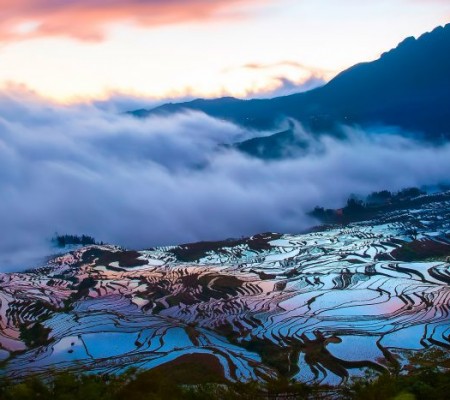
Fengle Village of Lashi Town in Yulong County, Lijiang
Geographical Location
Fengle Village(丰乐村)is located in Hainan Village Committee, Lashi Town, Yulong Naxi Autonomous County, Lijiang City. It lies in the west of the Lijiang Basin and is a typical plain village. Nestled beside Lashi Lake, the village is surrounded by green mountains with an average altitude of about 2400 meters. The climate here is pleasant, with an annual average temperature of 12.8℃ and an annual precipitation of 950 millimeters. The winter is warm without severe cold, and the summer is cool without scorching heat, making it suitable for growing crops such as rice, corn, and wheat.
Fengle Village has convenient transportation. It is about 12 kilometers away from Lijiang city center. Starting from Lijiang Ancient Town, it takes about 20 minutes to get there by driving along the Lijiang West Road. Lijiang Sanyi International Airport is not far from the village. It takes about 40 minutes to reach the village by airport bus or taxi. In addition, the surrounding road network is well – connected. Whether by car or public transport, it is easy to get there.
Ethnic Groups and Traditional Skills
Ethnic Composition
Fengle Village is mainly inhabited by the Naxi people, with a small number of Han and Bai people also living here. As one of the main ethnic groups in Lijiang, the Naxi people have preserved their rich ethnic traditions and customs, which form the core of the village’s culture. Different ethnic groups have lived in harmony for a long time, communicating and integrating with each other, creating a unique and diverse cultural atmosphere.
Traditional Skills
-
Naxi Handicraft Textile (纳西族手工纺织): Naxi women have inherited the ancient skill of handicraft textile – making. Using traditional wooden looms, they spin cotton grown locally or wool collected into yarn and weave it into cloth. During the weaving process, they incorporate techniques such as pattern – picking and embroidery to create auspicious patterns on the fabric, such as the sun, moon, stars, and flowers, birds, fish, and insects. These textiles are not only used for making daily clothing but also become handicrafts with strong ethnic characteristics. Tourists can visit local workshops to watch Naxi women weaving and even try it themselves to experience the charm of traditional skills.
-
Dongba Paper – making (东巴造纸): This unique Naxi paper – making process is complex and delicate. Using the local endemic Daphne genus plant, Daphne lichiangensis, as the raw material, it goes through many processes, including collection, drying, soaking, boiling, washing, pounding, paper – pouring, paper – sticking, and paper – drying. Dongba paper is strong and mothproof, serving as an important carrier for the inheritance of Dongba culture. It is often used for writing Dongba scriptures and drawing Dongba paintings. Although fewer and fewer people master this skill now, a few craftsmen in Fengle Village still adhere to this tradition. Tourists have the opportunity to visit the entire Dongba paper – making process and understand the mysteries of this ancient skill.
-
Woodcarving (木雕工艺): The Naxi woodcarving skill is also popular in Fengle Village. Villagers select high – quality wood, such as azalea wood and walnut wood. After being carefully carved by craftsmen, various woodcarving works are produced. The patterns cover a wide range of topics, including myths and legends, historical stories, and natural scenery. Woodcarving works are not only used for architectural decoration, such as doors and windows and beams, but also made into woodcarving ornaments and pendants. The carving style is rough but delicate, with strong ethnic characteristics. The woodcarving workshops in the village welcome tourists to visit, admire the craftsmen’s superb skills, and buy some woodcarving works they like as souvenirs.
Customs and Festivals
Daily Customs
-
Dietary Customs (饮食习俗): The diet of Fengle villagers is mainly characterized by Naxi cuisine. The staple foods include rice and noodles, and the local specialties include smoked pork ribs and baba. The Naxi people pay great attention to respecting the elderly and honoring the elders during meals. The younger generations must wait for the elders to start eating before they can begin. In addition, due to the proximity to Lashi Lake, villagers often eat fresh fish and seafood. The cooking methods are diverse, such as steaming, braising, and stewing, and the taste is delicious.
-
Living Customs (居住习俗): The buildings in the village are mostly traditional Naxi “Three Rooms and One Screen Wall” and “Four – Courtyard and Five Sky – wells” earth – wood – structure houses. The “Three Rooms and One Screen Wall” is composed of the main room, two side rooms, and a screen wall. The screen wall is usually built with bricks and stones and is decorated with beautiful patterns of landscapes and flowers and birds. It is both beautiful and functional for wind – blocking and lighting. The main room is high and spacious, facing north to south, and serves as the center of family activities, while the side rooms are used for living or storing items. The layout of the houses emphasizes integration with the natural environment, with flowers and fruit trees planted in the courtyards to create a comfortable and pleasant living atmosphere.
Important Festivals
-
Sanduo Festival (三朵节): On the eighth day of the second lunar month every year, the Naxi people celebrate the grand Sanduo Festival to worship their ethnic protector god “Sanduo”. The Naxi villagers in Fengle Village dress in their finest clothes and go to the nearby Sanduo Temple to offer rich sacrifices, praying for favorable weather, abundant harvests, and prosperity of livestock. After the sacrifice, everyone gathers together to perform traditional dances such as Ali Li and Dajiao, creating a lively atmosphere. During the festival, the village also holds traditional sports activities such as horse racing and wrestling to show the vitality and charm of the Naxi people.
-
Torch Festival (火把节): On the twenty – fourth day of the sixth lunar month, the Yi, Bai, and other ethnic groups jointly celebrate the Torch Festival, and some Naxi people also participate. On that evening, every household sets up a tall torch in front of their door, made of pine torches and firewood, and decorated with colorful flags. As night falls, the torches are lit. Villagers hold small torches and parade around the big torch, chanting blessings. Subsequently, a grand bonfire party is held, with people singing and dancing around the bonfire, creating a spectacular scene. In Fengle Village, the Torch Festival is also a good opportunity for friends and relatives to get together and strengthen their relationships.
-
Naxi New Year (纳西族新年): The Naxi New Year (in the twelfth lunar month) is also grand. From the twelfth lunar month, every household begins to get busy, cleaning the house and preparing New Year’s goods. On New Year’s Eve, the whole family gathers for the New Year’s Eve dinner and worships their ancestors. On the first day of the New Year, people get up early, put on new clothes, visit relatives and friends, and exchange greetings. During this period, various traditional folk activities such as Dongba scripture – chanting and Naxi ancient music performances are held, filling the air with a strong national cultural atmosphere.
Ancient Architecture
Fengle Village has preserved many ancient buildings with Naxi characteristics. Traditional residences are mainly made of earth and wood, with an antique and elegant architectural style. The layout forms of “Three Rooms and One Screen Wall” and “Four – Courtyard and Five Sky – wells” reflect the unique architectural wisdom and aesthetic concepts of the Naxi people. The doors, windows, and beams of the houses are carved with exquisite patterns. These woodcarving skills are exquisite, with smooth lines and vivid shapes. The topics are rich and diverse, such as “dragon and phoenix bringing good luck” and “pine and crane living long”, with high artistic value. Some ancient buildings also retain ancient murals. The colors are bright, and the content is mostly about Naxi myths and historical stories, vividly showing the cultural inheritance of the Naxi people. In recent years, the local government has increased the protection of ancient buildings. Some dilapidated ancient buildings have been repaired and maintained, so that they can better show the historical and cultural style of the Naxi people.
Tourism Resources
Natural Scenery
-
Lashi Lake Scenery (拉市海风光): Fengle Village is adjacent to Lashi Lake, which is the first nature reserve named “wetland” in Yunnan Province. The lake water is clear, the grass is lush, and the surrounding mountains are beautiful. Every autumn and winter, a large number of migratory birds fly from the north to stay and spend the winter here, forming a unique landscape. Tourists can walk along the lake, enjoy the lake and mountain views, and choose to ride a horse along the lakeside path to experience the tranquility and beauty of nature. In addition, Lashi Lake is also an excellent place for bird – watching. Tourists can bring binoculars to observe various rare birds and learn about their living habits.
-
Rural Landscape (田园风光): The surrounding area of the village is surrounded by vast and fertile farmland, with different scenery in each season. In spring, tender green seedlings of crops break through the soil, full of vitality; in summer, crops grow vigorously, with a sea of green; in autumn, the golden rice and full corn crops are harvested, and the fields are covered with yellow; in winter, although the fields are a bit desolate, the distant mountains and fields form a quiet ink – wash painting. Tourists can walk in the fields, participate in agricultural activities such as sowing and harvesting, and experience the fun of rural life and the gifts of nature.
Cultural Scenery
-
Naxi Cultural Experience (纳西族文化体验): Visitors can delve into Naxi families to experience their daily lives. Learn traditional skills such as Naxi handicraft textile – making, Dongba paper – making, and woodcarving, taste Naxi – specific cuisine, and participate in family sacrifices. The village regularly holds Naxi cultural activities such as Dongba scripture – chanting ceremonies, Naxi dance performances, and Naxi ancient music performances. Visitors can actively participate to gain a deeper understanding of the unique cultural connotations of the Naxi people.
-
Ancient Architecture Tour (古建筑游览): Visit traditional residences and other ancient buildings to appreciate the unique architectural style and cultural connotations of the Naxi people. With the guidance of a tour guide or local villagers, learn about the historical stories and cultural significance behind these ancient buildings. Some residences have been transformed into folk museums or guesthouses, where visitors can choose to stay and experience a combination of tradition and modernity, feeling the living atmosphere of the Naxi people.
Leisure and Entertainment
-
Farm – Stay Experience (农家乐体验): There are many farm – stays around Fengle Village, where visitors can taste authentic local dishes such as Naxi smoked pork ribs, free – range chicken hot pot, and various wild vegetables. Farm – stays also offer accommodation services, allowing visitors to experience the tranquility and comfort of rural life. In addition, some farm – stays have leisure and entertainment facilities such as card rooms and picking gardens, where visitors can relax while having fun.
-
Folk Activity Participation (民俗活动参与): Participate in traditional folk activities in the village, such as bonfire evenings. As night falls, a bonfire is lit in the village square. Visitors join the Naxi villagers to dance around the bonfire, learn traditional Naxi dances, and feel the enthusiasm and hospitality of the Naxi people. You can also participate in traditional handicraft competitions and agricultural sports activities to add fun to your trip.
Transportation Guide
External Transportation
-
By Air (飞机): After arriving at Lijiang Sanyi International Airport, you can take an airport bus to Lijiang city center and then transfer to a bus or taxi to Lashi Town and Fengle Village. There are several routes of airport buses, and you can choose the appropriate one according to your destination. Taking a taxi to Fengle Village takes about 40 minutes, and the cost depends on the type of vehicle and the actual distance.
-
By Train (火车): After arriving at Lijiang Station by train, take a bus to Lashi Town at the bus station next to the station. Then transfer to a local rural passenger vehicle or taxi to Fengle Village. Lijiang Station has trains to major cities across the country, and the transportation is convenient.
-
By Car (汽车): If departing from a nearby city, you can take a long – distance bus directly to Lijiang Passenger Station. Lijiang has frequent bus services to surrounding cities such as Dali and Kunming. After arriving at Lijiang Passenger Station, transfer to a vehicle heading to Lashi Town and then to Fengle Village.
Internal Transportation
-
Rural Passenger Transport (农村客运): There are rural passenger vehicles from Lijiang city center to Lashi Town. After arriving in Lashi Town, you can transfer to a minibus or van to Fengle Village. The operating hours and schedules of rural passenger vehicles can be inquired at the local passenger station. This mode of transportation is economical, but there may be fewer buses, so you need to arrange your time reasonably.
-
Chartering a Car (包车): You can choose to charter a vehicle in Lijiang city center or Lashi Town to Fengle Village.

 7 Days GolfingTour
7 Days GolfingTour
 8 Days Group Tour
8 Days Group Tour
 8 Days Yunnan Tour
8 Days Yunnan Tour
 7 Days Shangri La Hiking
7 Days Shangri La Hiking
 11 Days Yunnan Tour
11 Days Yunnan Tour
 6 Days Yuanyang Terraces
6 Days Yuanyang Terraces
 11 Days Yunnan Tour
11 Days Yunnan Tour
 8 Days South Yunnan
8 Days South Yunnan
 7 Days Tea Tour
7 Days Tea Tour
 8 Days Muslim Tour
8 Days Muslim Tour
 12 Days Self-Driving
12 Days Self-Driving
 4 Days Haba Climbing
4 Days Haba Climbing
 Tiger Leaping Gorge
Tiger Leaping Gorge
 Stone Forest
Stone Forest
 Yunnan-Tibet
Yunnan-Tibet
 Hani Rice Terraces
Hani Rice Terraces
 Kunming
Kunming
 Lijiang
Lijiang
 Shangri-la
Shangri-la
 Dali
Dali
 XishuangBanna
XishuangBanna
 Honghe
Honghe
 Kunming
Kunming
 Lijiang
Lijiang
 Shangri-la
Shangri-la
 Yuanyang Rice Terraces
Yuanyang Rice Terraces
 Nujiang
Nujiang
 XishuangBanna
XishuangBanna
 Spring City Golf
Spring City Golf
 Snow Mountain Golf
Snow Mountain Golf
 Stone Mountain Golf
Stone Mountain Golf





